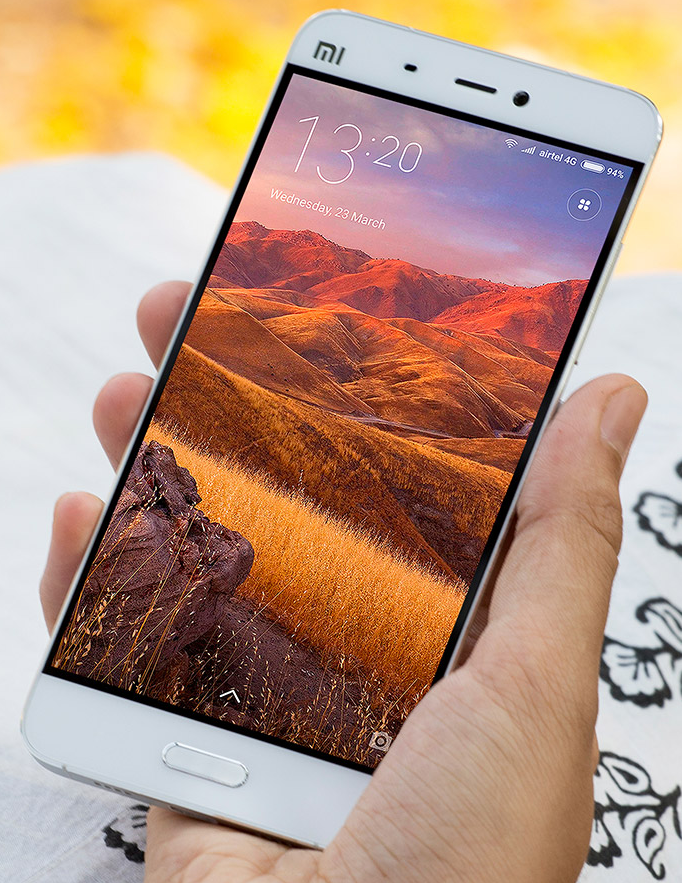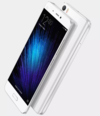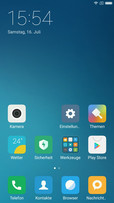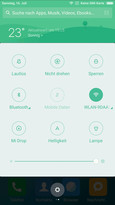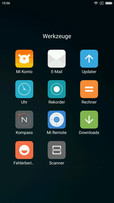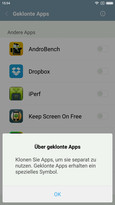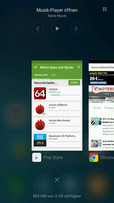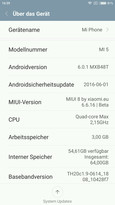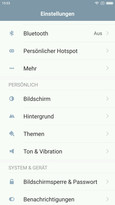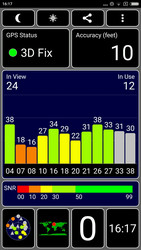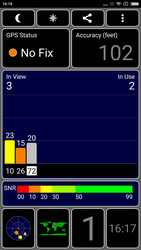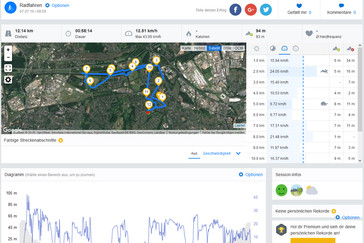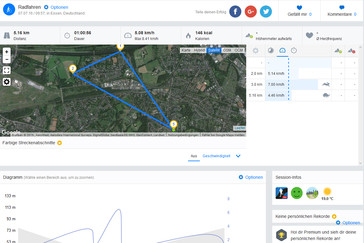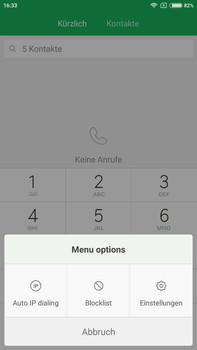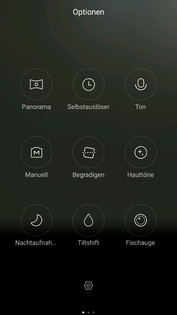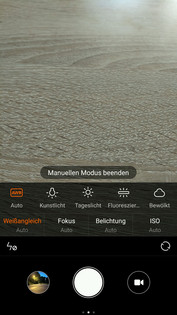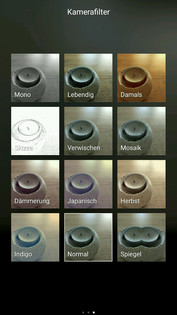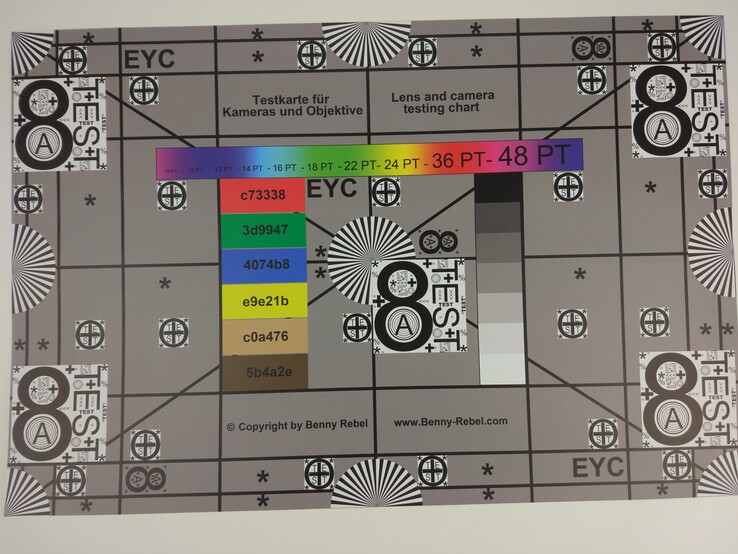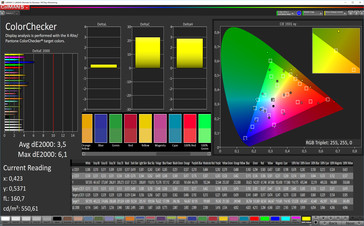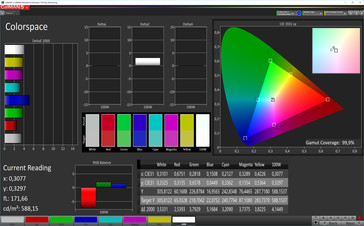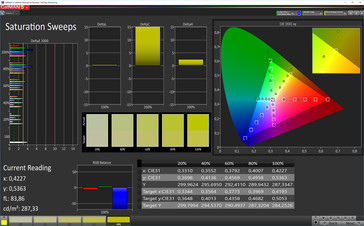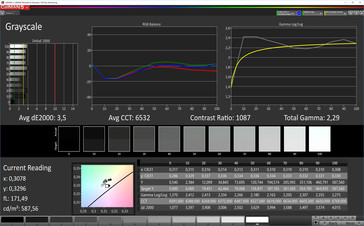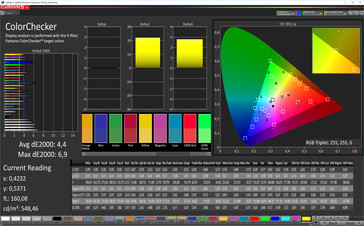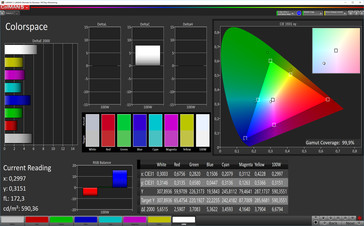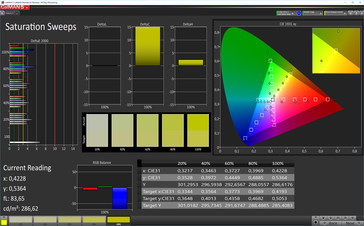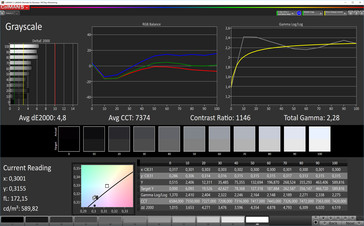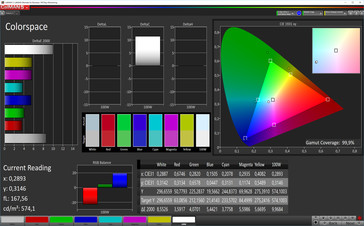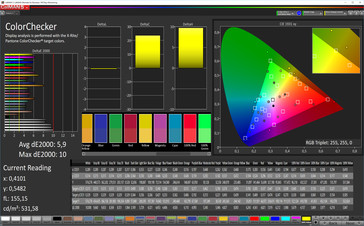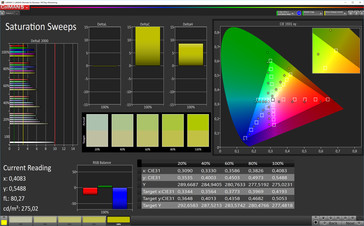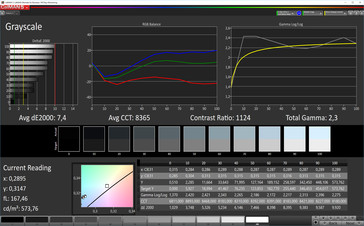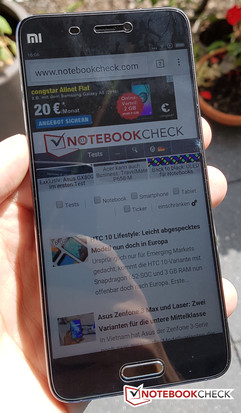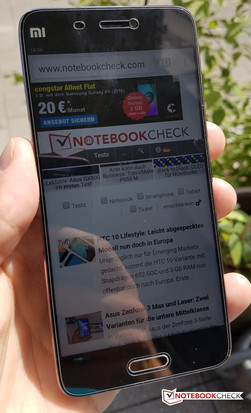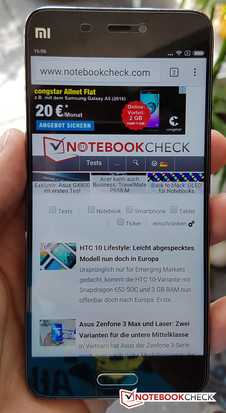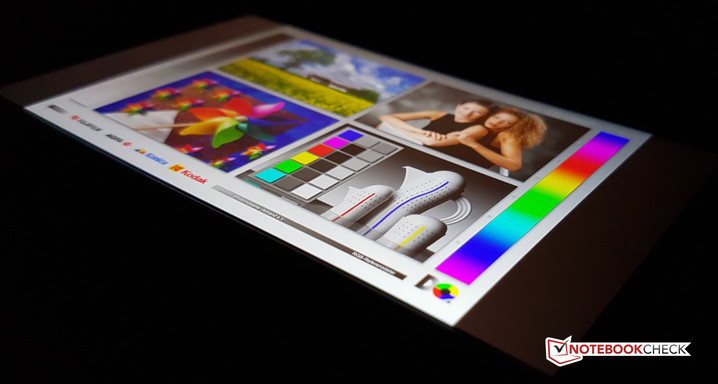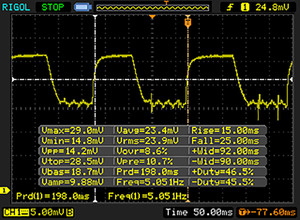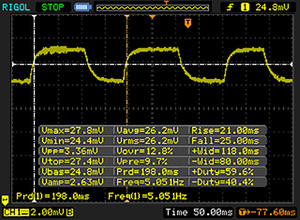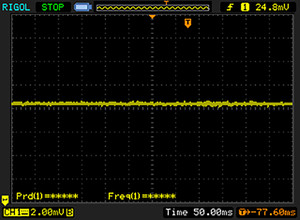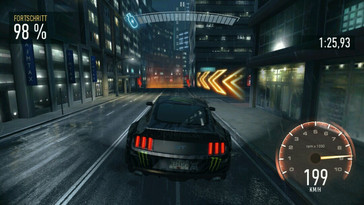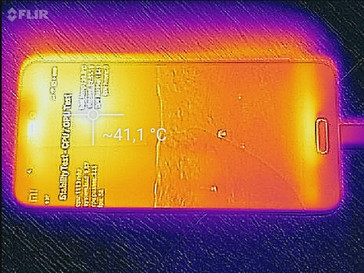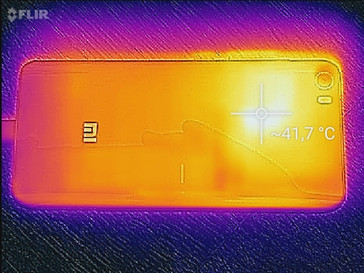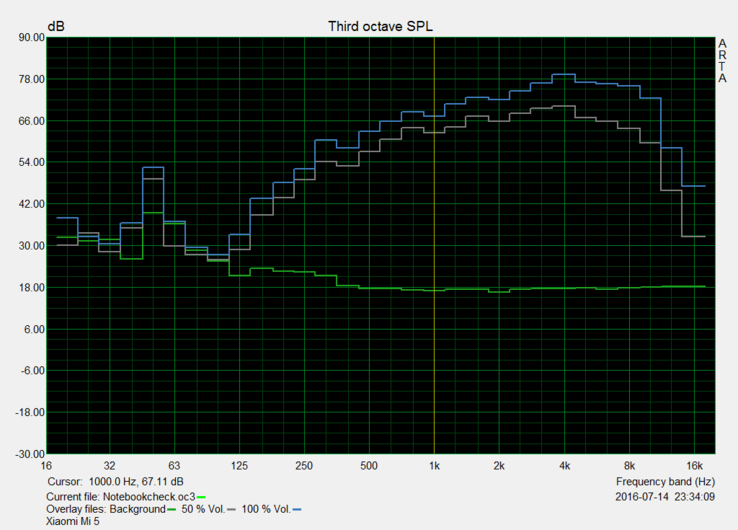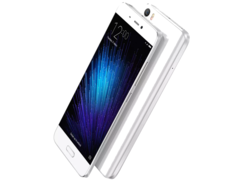Xiaomi Mi 5 Smartphone Review
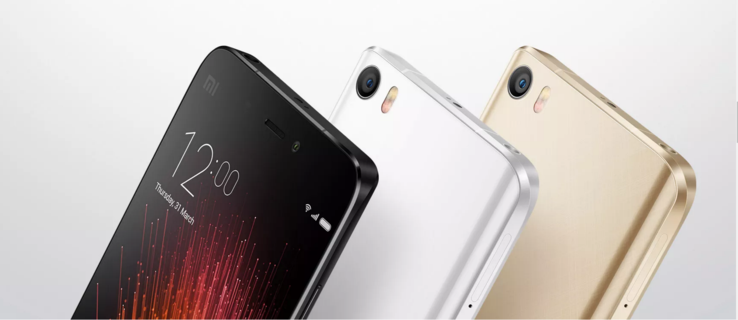
For the original German review, see here.
Last year's vertical takeoff tycoon on the Chinese smartphone market, Xiaomi Tech, presented the fifth generation Mi Phone at this year's Mobile World Congress 2016 (we reported). In addition to premium specs, the Mi5 is to succeed with an outstanding price-performance ratio. Xiaomi's handset costs just half the price of flagship models by other manufacturers.
The manufacturer's premium model features 128 GB of internal storage and 4 GB of working memory (460 Euros, ~$509) - we were provided with Xiaomi's Mi5 in the 64 GB and 3 GB RAM (370 Euros, ~$409) version for the test. The high-end smartphone is powered by Qualcomm's latest high-performance quad-core SoC - the Snapdragon 820 - alongside an Adreno 530 graphics unit. The 5.15-inch IPS panel has a Full HD resolution of 1920x1080 pixels which results in a pixel density of 428 PPI. Further specs include a USB Type-C port, 3000 mAh battery and fingerprint scanner integrated into the physical home button. The 16 MP primary camera in the Mi 5 uses an optical 4 axis image stabilizer (OIS). A 4 MP front-facing camera with especially large image pixels (2 µm) is present for selfies.
Xiaomi's Mi5 is available in gold, white or black. Its potential rivals are Samsung's Galaxy S7, HTC's 10, LG's G5, OnePlus' 3, and Huawei's P9 although Xiaomi's handset is comparatively cheap at a price of just below 300 Euros (~$332, 32 GB, importers). Direct retail of the Mi5 is not intended for the European market.
Case
The casing's front and rear are made of Corning Gorilla Glass 4. Xiaomi calls this "3D Glass Body Design". The curved glass back on the long lateral sides merges into a metal bezel - the transition is very palpable and not as elegantly solved as in Samsung's Galaxy S7. A very narrow, black, lateral frame only limits the IPS panel in Xiaomi's Mi5. The edges on the lower and upper sides are also relatively small, and thus the screen to casing's front side has a good ratio of 73.1%.
The metal buttons for volume control and power on the casing's right are comfortable to reach, hardly wobble, and they have a pleasant pressure point. The same is true for the home button on the handset's front. Despite the low height of 7.25 millimeters and optical image stabilizer, the rear-facing primary camera does not jut out of the casing.
The casing's feel, handiness, and stability are very good - nothing creaks or cracks when twisting the Mi5. The build quality is roughly on par with other devices from the premium range.
Connectivity
The internal UFS 2.0 storage in the Mi5 has a capacity of 64 GB. The user only has 53.82 GB for personal use in delivery state. Depending on the requirement profile, it should be noted that the flash memory cannot be expanded. The Mi5's 3000 mAh battery is charged via a modern USB C port with Quickcharge 3.0 on the handset's lower edge. The micro USB port, however, only transfers data in the 2.0 standard. In return, the port identifies external peripherals via USB OTG (on-the-go).
A fingerprint scanner, Wi-Fi Direct, an infrared sensor, a compass, and a status LED are also installed in the Mi5. Wireless transmission of screen content to external monitors via Miracast is also supported, and it functioned very well in conjunction with a Sony Android TV in the test.
| SD Card Reader | |
| maximum SDCardreader Maximum Transfer Rate | |
| average SDCardreader Average Transfer Rate |
Software
Since Xiaomi Mi5 smartphones are originally intended for the Chinese market, they do not support Google services like the Play Store or apps like Gmail or Google Maps ex-factory. Instead, they are shipped with Chinese services and Xiaomi's own services. Also, only Chinese and English can be selected as the system language. The preloaded MIUI operating system in version 8 (global ROM including Google services) in our review sample is based on Android 6.0.1 Marshmallow (tutorial multi-ROM).
The user can customize the design via Xiaomi's Theme Store. However, most of the alternative themes present a similar style as MIUI: Colorful and somewhat cluttered. Installed applications are distributed over the home screen; there is no app drawer.
The setting options are very diverse in MIUI 8. The custom ROM also has interesting features: For example, apps can be cloned and used separately. Beyond that, a second profile can be configured so that private content can be stored in a separate profile partition.
Communication & GPS
The latest Bluetooth version 4.2 and an NFC chip are available for wireless near-field communication. The integrated Wi-Fi module in the Mi5 supports the IEEE 802.11 a/b/g/n/ac standards, and thus it transmits in both the 2.4 and 5 GHz frequencies. Both the range and signal stability are very good. The Wi-Fi transmission speed between the smartphone and our Linksys EA 8500 reference router is on par with current high-end devices. The Mi5 even achieves the best rate in our smartphone database with 316 Mbit/s (iperf server). The data rates were stable and did not fluctuate significantly during the test.
The dual-SIM smartphone sports two slots for nano-SIM cards. Both support LTE Cat.9 and thus can access mobile Internet at up to 450 MB/s (download) and 50 MB/s (upload). The Mi 5 supports quad-band GSM, quad-band UMTS, and LTE in 1800, 2100, and 2600 MHz frequencies. Here, it becomes clear that Xiaomi's devices are not made for the German market as LTE band 20 is absent. The supported frequencies are comparatively limited.
Localization is performed via main satellite systems: GPS, GLONASS, and Beidou. Satellites were found quickly outdoors with an accuracy of approximately 3 meters. Using the Mi5 for localization indoors did not function. To evaluate the tracking accuracy of our review sample in practice, we record a route for comparison reasons using Garmin's Edge 500 GPS bike computer and the smartphone. The Mi5 apparently only keeps the GPS signal when activated and not in standby. Thus, only the places where we activated the handset for shooting photos were logged in the test. Since the preloaded ROM on our review sample is a beta version, this could be fixed in the final version.
| Networking | |
| iperf Server (receive) TCP 1 m | |
| Xiaomi Mi 5 | |
| LG G5 | |
| OnePlus 3 | |
| Huawei P9 | |
| iperf Client (transmit) TCP 1 m | |
| Xiaomi Mi 5 | |
| OnePlus 3 | |
| Huawei P9 | |
| LG G5 | |
Telephone & Call Quality
The intelligibility during a test call using the German Vodafone network was very good, and the earpiece's maximum volume was sufficient. Voice sounded very natural, and our contact described the installed microphone's quality as well-intelligible.
The camera often stopped recording during video calls during Skype, making it necessary to restart the video chat.
Cameras
The 16 MP primary camera in the Mi5 has a resolution of 4608x 3456 pixels at an aspect ratio of 4:3. The camera module features an aperture of f/2.0 and a 28-millimeter objective. The installed 1/2.8-inch Sony CMOS image sensor (IMX298) is also used, for example, in OnePlus' 3. The pixel edge length of 1.12 micrometers is considerably smaller than in other Sony sensors that, for example, are installed in Samsung's Galaxy S7 (1.4 µm) or HTC's 10 (1.55 µm). Xiaomi uses the so-called "Deep-Trench-Isolation" technology for the first time. It reduces the artifacts between neighboring photodiodes.
Good to very good photos with high image sharpness (scene 3: surroundings) are possible with the Mi5. The dynamic range is on par with the rivals. Compared with OnePlus' 3 with the same sensor model, details are not displayed quite as rich. The light absorption is on par with Samsung's Galaxy S7 (f/1.7) in low-light conditions despite lower aperture and pixel edge length (scene 2: night). However, the image sharpness often suffers under the long exposure time - despite an optical four-axis image stabilizer for stabilizing movements.
The 4 MP front-facing camera is also good quality and is more than sufficient for selfies. The front-facing camera in the Mi5 records videos in the FHD resolution (1920x1080 pixels) at up to 30 frames per second. The 16 MP primary camera records videos in the 4K resolution (4096x2160 pixels) at 30 FPS and slow motion shots in 720p at 120 FPS.
Accessories & Warranty
In addition to the smartphone, the box of our review sample contained a user manual in Chinese, a protection cover, USB cable, and modular power supply. Beyond that, the Mi5 was delivered with an EU adapter for the regional power outlets. However, it does not belong to the standard accessories but is a service by the loaner, Trading Shenzhen, which every buyer receives.
The warranty period is 12 months. Our review sample, provided by Trading Shenzhen, can be sent to a German dispatch address in case of a warranty claim. Thus, time-consuming shipping to China would not become necessary.
Input Devices & Handling
Xiaomi does not use onscreen navigation in its flagship handset. Three buttons for control are situated under the screen. The physical home button with an integrated fingerprint scanner is in the center. Two backlit, touch-sensitive buttons for "multitasking" and "back" are on its left and right. Xiaomi uses a simple point design like known, for example, from ZTE smartphones. These points are automatically turned on and off during use.
Unlocking the handset via biometric identification, i.e. fingerprint, functioned reliably and at a similar speed as in Samsung's Galaxy S7. Both handsets also have the passive fingerprint scanner in common. This means that the Mi5 first has to be awakened from standby before the user can unlock it.
The capacitive multi-touchscreen responds to inputs very accurately into the screen's lateral areas. Xiaomi preloads the stock Android keyboard by Google for text inputting.
Display
The IPS panel in the Mi5 has a diagonal of 13.1 centimeters (5.15-inches) and has the Full High Definition resolution of 1920x1080 pixels. That results in a pixel density of approximately 429 PPI, and thus content is displayed very sharply. The available resolution is more than sufficient for everyday use although it cannot offer the WQHD resolution (2560x1440 pixels) of Samsung's Galaxy S7.
The maximum screen brightness of 598 cd/m² is very bright and also very homogeneous at 90%. We determined a similar rate of 571 cd/m² when measuring the screen's brightness with equally distributed bright and dark areas (APL 50). The Mi5's screen achieves a rate of 541 cd/m² when the adaptive light sensor for controlling the screen's brightness is enabled.
| |||||||||||||||||||||||||
Brightness Distribution: 90 %
Center on Battery: 598 cd/m²
Contrast: 1173:1 (Black: 0.51 cd/m²)
ΔE ColorChecker Calman: 3.5 | ∀{0.5-29.43 Ø4.83}
ΔE Greyscale Calman: 3.5 | ∀{0.09-98 Ø5.1}
Gamma: 2.29
CCT: 6532 K
| Xiaomi Mi 5 IPS, 1920x1080, 5.2" | Samsung Galaxy S7 SAMOLED, 2560x1440, 5.1" | LG G5 IPS Quantum, 2560x1440, 5.3" | Huawei P9 IPS-NEO, JDI, 1920x1080, 5.2" | HTC 10 Super LCD 5, 2560x1440, 5.2" | OnePlus 3 Optic-AMOLED, 1920x1080, 5.5" | |
|---|---|---|---|---|---|---|
| Screen | 12% | -21% | -4% | 1% | -28% | |
| Brightness middle | 598 | 350 -41% | 784 31% | 582 -3% | 445 -26% | 419 -30% |
| Brightness | 566 | 351 -38% | 774 37% | 563 -1% | 434 -23% | 431 -24% |
| Brightness Distribution | 90 | 98 9% | 91 1% | 91 1% | 93 3% | 84 -7% |
| Black Level * | 0.51 | 0.43 16% | 0.38 25% | 0.36 29% | ||
| Contrast | 1173 | 1823 55% | 1532 31% | 1236 5% | ||
| Colorchecker dE 2000 * | 3.5 | 2.04 42% | 6.5 -86% | 4.4 -26% | 2.8 20% | 4.1 -17% |
| Colorchecker dE 2000 max. * | 6.1 | 3.25 47% | 11.7 -92% | 7.4 -21% | 5.8 5% | 12 -97% |
| Greyscale dE 2000 * | 3.5 | 1.63 53% | 8 -129% | 4.8 -37% | 3.7 -6% | 3.3 6% |
| Gamma | 2.29 96% | 2.07 106% | 2.22 99% | 2.2 100% | 2.31 95% | 2.1 105% |
| CCT | 6532 100% | 6391 102% | 8699 75% | 6175 105% | 7164 91% | 6550 99% |
| Color Space (Percent of AdobeRGB 1998) | 86.86 | 68.08 | 77.78 | 89.38 | ||
| Color Space (Percent of sRGB) | 99.35 | 97.46 | 99.44 | 100 |
* ... smaller is better
We cannot confirm Xiaomi's specified contrast of 1500:1 in the test. Our measurements resulted in a contrast of 1137:1 at a black level of 0.51 cd/m² (APL 50: 0.74 cd/m², 808:1). Seen subjectively, both the black level and contrast are absolutely satisfactory. However, the rivals provide slightly better screen rates objectively. Then again, the Mi5 scores in color and grayscale reproduction (display mode: warm). The analysis using a photospectrometer and CalMAN software only presents minor shifts in color (3.5) and grayscale (3.5) reproduction. Furthermore, the measured color temperature of 6532 Kelvin is very close to the ideal rate of 6500 Kelvin. The rates were a bit worse in the other two display modes.
Displayed content is very well-legible outdoors thanks to the bright liquid crystal display. The Mi5 also scores very well in terms of viewing-angle stability - colors do not invert thanks to the IPS panel, and the reproduction barely changes in flat viewing angles.
Display Response Times
| ↔ Response Time Black to White | ||
|---|---|---|
| 40 ms ... rise ↗ and fall ↘ combined | ↗ 15 ms rise | |
| ↘ 25 ms fall | ||
| The screen shows slow response rates in our tests and will be unsatisfactory for gamers. In comparison, all tested devices range from 0.1 (minimum) to 240 (maximum) ms. » 97 % of all devices are better. This means that the measured response time is worse than the average of all tested devices (20.5 ms). | ||
| ↔ Response Time 50% Grey to 80% Grey | ||
| 46 ms ... rise ↗ and fall ↘ combined | ↗ 21 ms rise | |
| ↘ 25 ms fall | ||
| The screen shows slow response rates in our tests and will be unsatisfactory for gamers. In comparison, all tested devices range from 0.165 (minimum) to 636 (maximum) ms. » 78 % of all devices are better. This means that the measured response time is worse than the average of all tested devices (32 ms). | ||
Screen Flickering / PWM (Pulse-Width Modulation)
| Screen flickering / PWM not detected | |||
In comparison: 53 % of all tested devices do not use PWM to dim the display. If PWM was detected, an average of 8320 (minimum: 5 - maximum: 343500) Hz was measured. | |||
Performance
Xiaomi installs one of the presently strongest processors on the market with the Snapdragon 820. Qualcomm's SoC integrates 4 CPU cores from its own Kryo architecture with 64-bit support. As the benchmark scores prove, the Snapdragon 820 (1.8 GHz clock rate) alongside 3 GB of DDR4 RAM ensures a similarly high performance as current premium devices by other manufacturers and even top rates in graphics-driven calculations.
Both system performance and browser speed are also outstanding. The system runs very smoothly and almost lag-free in everyday use. A big advantage of the MIUI software: System animations can be disabled in the settings menu. That increases the subjective system speed even more and turns the Mi5 into one of the highest-performance smartphones on the market. Even Samsung's Galaxy S7 cannot keep up in the direct comparison.
Applications open and close quickly thanks to the strong SoC as well as the modern UFS 2.0 flash memory in the Mi5, which is one of the fastest smartphone storage devices on the market. Solely OnePlus' 3 achieves similarly good access rates as Xiaomi's smartphone in the AndroBench 3 test.
| AndroBench 3-5 | |
| Random Write 4KB (sort by value) | |
| Xiaomi Mi 5 | |
| Samsung Galaxy S7 | |
| LG G5 | |
| Huawei P9 | |
| HTC 10 | |
| OnePlus 3 | |
| Random Read 4KB (sort by value) | |
| Xiaomi Mi 5 | |
| Samsung Galaxy S7 | |
| LG G5 | |
| Huawei P9 | |
| HTC 10 | |
| OnePlus 3 | |
| Sequential Write 256KB (sort by value) | |
| Xiaomi Mi 5 | |
| Samsung Galaxy S7 | |
| LG G5 | |
| Huawei P9 | |
| HTC 10 | |
| OnePlus 3 | |
| Sequential Read 256KB (sort by value) | |
| Xiaomi Mi 5 | |
| Samsung Galaxy S7 | |
| LG G5 | |
| Huawei P9 | |
| HTC 10 | |
| OnePlus 3 | |
| AnTuTu v6 - Total Score (sort by value) | |
| Xiaomi Mi 5 | |
| Samsung Galaxy S7 | |
| LG G5 | |
| Huawei P9 | |
| HTC 10 | |
| OnePlus 3 | |
| Geekbench 3 | |
| 64 Bit Single-Core Score (sort by value) | |
| Xiaomi Mi 5 | |
| Samsung Galaxy S7 | |
| LG G5 | |
| Huawei P9 | |
| HTC 10 | |
| OnePlus 3 | |
| 64 Bit Multi-Core Score (sort by value) | |
| Xiaomi Mi 5 | |
| Samsung Galaxy S7 | |
| LG G5 | |
| Huawei P9 | |
| HTC 10 | |
| OnePlus 3 | |
| 3DMark | |
| 1280x720 offscreen Ice Storm Unlimited Score (sort by value) | |
| Xiaomi Mi 5 | |
| Samsung Galaxy S7 | |
| LG G5 | |
| Huawei P9 | |
| HTC 10 | |
| OnePlus 3 | |
| 1280x720 offscreen Ice Storm Unlimited Graphics Score (sort by value) | |
| Xiaomi Mi 5 | |
| Samsung Galaxy S7 | |
| LG G5 | |
| Huawei P9 | |
| HTC 10 | |
| OnePlus 3 | |
| 1280x720 offscreen Ice Storm Unlimited Physics (sort by value) | |
| Xiaomi Mi 5 | |
| Samsung Galaxy S7 | |
| LG G5 | |
| Huawei P9 | |
| HTC 10 | |
| OnePlus 3 | |
| 2560x1440 Sling Shot OpenGL ES 3.0 (sort by value) | |
| Xiaomi Mi 5 | |
| Samsung Galaxy S7 | |
| LG G5 | |
| Huawei P9 | |
| HTC 10 | |
| OnePlus 3 | |
| 2560x1440 Sling Shot OpenGL ES 3.0 Graphics (sort by value) | |
| Xiaomi Mi 5 | |
| Samsung Galaxy S7 | |
| LG G5 | |
| Huawei P9 | |
| HTC 10 | |
| OnePlus 3 | |
| 2560x1440 Sling Shot OpenGL ES 3.0 Physics (sort by value) | |
| Xiaomi Mi 5 | |
| Samsung Galaxy S7 | |
| LG G5 | |
| Huawei P9 | |
| HTC 10 | |
| OnePlus 3 | |
| GFXBench (DX / GLBenchmark) 2.7 | |
| T-Rex Onscreen (sort by value) | |
| Xiaomi Mi 5 | |
| Samsung Galaxy S7 | |
| LG G5 | |
| Huawei P9 | |
| HTC 10 | |
| OnePlus 3 | |
| 1920x1080 T-Rex Offscreen (sort by value) | |
| Xiaomi Mi 5 | |
| Samsung Galaxy S7 | |
| LG G5 | |
| Huawei P9 | |
| HTC 10 | |
| OnePlus 3 | |
| GFXBench 3.0 | |
| on screen Manhattan Onscreen OGL (sort by value) | |
| Xiaomi Mi 5 | |
| Samsung Galaxy S7 | |
| LG G5 | |
| Huawei P9 | |
| HTC 10 | |
| OnePlus 3 | |
| 1920x1080 1080p Manhattan Offscreen (sort by value) | |
| Xiaomi Mi 5 | |
| Samsung Galaxy S7 | |
| LG G5 | |
| Huawei P9 | |
| HTC 10 | |
| OnePlus 3 | |
| GFXBench 3.1 | |
| on screen Manhattan ES 3.1 Onscreen (sort by value) | |
| Xiaomi Mi 5 | |
| Samsung Galaxy S7 | |
| LG G5 | |
| Huawei P9 | |
| HTC 10 | |
| OnePlus 3 | |
| 1920x1080 Manhattan ES 3.1 Offscreen (sort by value) | |
| Xiaomi Mi 5 | |
| Samsung Galaxy S7 | |
| LG G5 | |
| Huawei P9 | |
| HTC 10 | |
| OnePlus 3 | |
| GFXBench | |
| 1920x1080 Car Chase Offscreen (sort by value) | |
| Xiaomi Mi 5 | |
| Samsung Galaxy S7 | |
| LG G5 | |
| Huawei P9 | |
| HTC 10 | |
| OnePlus 3 | |
| on screen Car Chase Onscreen (sort by value) | |
| Xiaomi Mi 5 | |
| Samsung Galaxy S7 | |
| LG G5 | |
| Huawei P9 | |
| HTC 10 | |
| OnePlus 3 | |
| PCMark for Android - Work performance score (sort by value) | |
| Xiaomi Mi 5 | |
| Samsung Galaxy S7 | |
| LG G5 | |
| Huawei P9 | |
| HTC 10 | |
| OnePlus 3 | |
| Mozilla Kraken 1.1 - Total (sort by value) | |
| Xiaomi Mi 5 | |
| Samsung Galaxy S7 | |
| LG G5 | |
| Huawei P9 | |
| HTC 10 | |
| OnePlus 3 | |
| JetStream 1.1 - Total Score (sort by value) | |
| Xiaomi Mi 5 | |
| Samsung Galaxy S7 | |
| LG G5 | |
| Huawei P9 | |
| HTC 10 | |
| OnePlus 3 | |
| Octane V2 - Total Score (sort by value) | |
| Xiaomi Mi 5 | |
| Samsung Galaxy S7 | |
| LG G5 | |
| Huawei P9 | |
| HTC 10 | |
| OnePlus 3 | |
* ... smaller is better
Games
As expected, up-to-date Android games such as N.O.V.A 3 or Need for Speed No Limits are no challenge for Qualcomm's Adreno 530 graphics unit in the Mi5. The incorporated position sensors and touchscreen sensitivity also function just as impeccably. Thus, precise game control is possible.
Emissions
Temperature
The temperature development during load is within the usual range for high-end smartphones. With a maximum temperature of 41.7 °C, the Mi5 heats up palpably but never gets unpleasantly hot. Xiaomi's handset barely heats up except for some areas with relatively high temperatures in idle mode.
(±) The maximum temperature on the upper side is 41.7 °C / 107 F, compared to the average of 35.2 °C / 95 F, ranging from 21.9 to 247 °C for the class Smartphone.
(±) The bottom heats up to a maximum of 40.1 °C / 104 F, compared to the average of 34 °C / 93 F
(+) In idle usage, the average temperature for the upper side is 31.5 °C / 89 F, compared to the device average of 32.9 °C / 91 F.
Speaker
The speaker in the Mi5 achieved a maximum volume of 87 dB(A) in our test. Consequently, the mono speaker on the handset's lower edge is quite powerful and offers a good sound. The sound does not make a very distorted impression even at full volume although it is treble-heavy as expected. The Pink Noise diagram illustrates that lower frequencies are barely audible. The 3.5 millimeter jack provides a clearer playback with considerably more basses.
Frequency diagram in comparison (check boxes above can be turned on/off!)
Rate 1: Pink Noise 100% volume; Rate 2: Audio off
Energy Management
Power Consumption
The Mi5 proves to be very efficient in terms of power consumption. It ranges on a level with the comparison devices. Solely Samsung's Galaxy S7 stands out from the opponents with a very low consumption.
| Off / Standby | |
| Idle | |
| Load |
|
Key:
min: | |
| Xiaomi Mi 5 3000 mAh | Samsung Galaxy S7 3000 mAh | LG G5 2800 mAh | Huawei P9 3000 mAh | HTC 10 3000 mAh | OnePlus 3 3000 mAh | |
|---|---|---|---|---|---|---|
| Power Consumption | 14% | -6% | -11% | -14% | 3% | |
| Idle Minimum * | 0.45 | 0.68 -51% | 0.55 -22% | 0.77 -71% | 0.68 -51% | 0.57 -27% |
| Idle Average * | 1.68 | 1.02 39% | 1.37 18% | 2.36 -40% | 1.49 11% | 1.24 26% |
| Idle Maximum * | 1.71 | 1.14 33% | 2.25 -32% | 2.37 -39% | 1.91 -12% | 1.36 20% |
| Load Average * | 6.7 | 4.73 29% | 6.24 7% | 3.09 54% | 7.4 -10% | 5.92 12% |
| Load Maximum * | 9.18 | 7.16 22% | 9.12 1% | 5.35 42% | 9.71 -6% | 10.53 -15% |
* ... smaller is better
Battery Runtime
A 3000 mAh battery supplies the Mi5 with power. The smartphone achieved a good outcome of 8 hours and 24 minutes in our Wi-Fi test using an adapted screen brightness of 150 cd/m².
Thanks to the supported Quickcharge 3.0 technology, the Mi5 is fully recharged in approximately 1 hour and 30 minutes with the included 12.5-watt power supply (5 V, 2.5 A).
| Xiaomi Mi 5 3000 mAh | Samsung Galaxy S7 3000 mAh | LG G5 2800 mAh | Huawei P9 3000 mAh | HTC 10 3000 mAh | OnePlus 3 3000 mAh | |
|---|---|---|---|---|---|---|
| Battery Runtime | ||||||
| WiFi v1.3 | 504 | 456 -10% | 387 -23% | 569 13% | 413 -18% | 840 67% |
Pros
Cons
Verdict
Xiaomi's newest flagship smartphone made a very good impression in our test, and there is not much to be criticized considering the price of a mid-range handset (street price: approx. 300 Euros, ~$332, 32 GB version). Only the availability in Germany in conjunction with the lack of LTE band 20 support is a problem particularly for E-network customers.
Compared with some considerably more expensive 2016 flagship handsets by other manufacturers, the Mi5 does not have a unique selling point like OnePlus' 3 (6 GB RAM), Huawei's P9 (dual-camera system), LG's G5 (modular design) or Samsung's Galaxy S7 (camera quality, IP67 certification) apart from its good price-performance ratio.
Xiaomi's Mi5 is an absolute purchase recommendation for anyone who can live with the connected restrictions/risks of an import device.
Buyers looking for an affordable, well-built smartphone based on a modern Snapdragon SoC, very good configuration, and an outstanding system performance will find Xiaomi's Mi5 is a worthy alternative to existing handsets from the premium range. The camera modules shoot good quality photos even if they are not first-rate.
Xiaomi Mi 5
- 07/20/2016 v5.1 (old)
Marcus Herbrich





